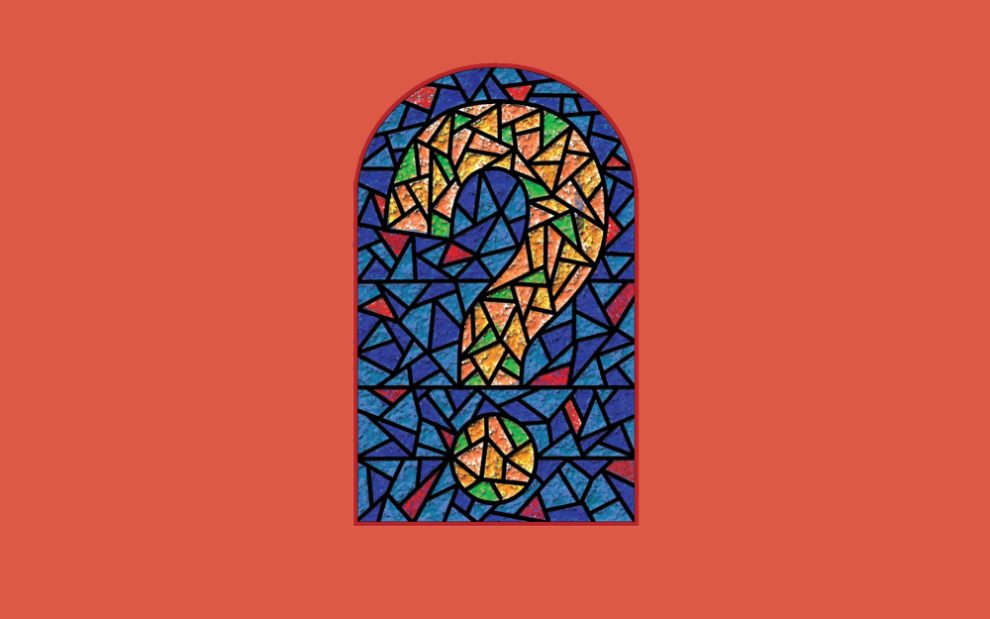Listen on: Apple | Google | Spotify
Over the two thousand years of its existence, the Catholic Church has developed complicated and elaborate leadership structures, with strict rules about who can take which roles and why. These structures can be confusing even for cradle Catholics, who may not be sure about the exact differences between a bishop and an archbishop, or what the different colored robes for different ranks in the church are meant to symbolize.
Some of the highest-ranking church leaders are easily recognizable for their bright red robes. These are the “cardinals” of the Catholic Church, and their tradition of wearing scarlet has been around for centuries. In fact, when European colonizers encountered bright red birds in the Americas, they named them after these similarly adorned princes of the Catholic Church.
But what is the role of cardinals in the church? What do they do? And how does one become a cardinal? Is it possible, as some Catholic reformers suggest, that the rank of cardinal might theoretically be open to women? On this episode of the podcast, guest Don Clemmer talks about the role cardinals play in the leadership and teaching of the church. Clemmer is the editor of Connection magazine for the NETWORK Lobby for Catholic Social Justice and coproducer of the Just Politics podcast. He has written extensively for U.S. Catholic, as well as for many other publications, and previously worked in the media relations office of the United States Conference of Catholic Bishops.
You can learn more about this topic, and read some of Clemmer’s writing, in these links.
- “How does the church choose its cardinals?” by John Switzer.
- “Can the church change?” by Don Clemmer.
- “Can you hear us? A look at the ongoing synod,” by Don Clemmer.
The following is a transcript of this episode of Glad You Asked:
Rebecca: Thank you so much for joining us on the Glad You Asked podcast.
Don: No, thank you for inviting me, Rebecca. It’s a delight to be here.
Emily: So before we talk about what cardinals do, can you say a little bit about who or what a cardinal is and why we actually call them cardinals?
Don: Sure. Nothing to do with the similarly red bird. The term emerges from the use of cardinal as we would hear in like, cardinal sin, cardinal virtue, like something pivotal that the title literally means hinge person.
And it stems from this fact that a cardinal as an advisor to the pope is this pivotal person, this confidant, this advisor who is important. And it stems from the role emerging basically out of when the church was much more insular, the bishop of Rome would have been relying on the clergy of confidants and advisors and that carries over to this day, that cardinals are technically the actual clergy of Rome, like they each have a titular church that they report to. They have different designations of cardinal priests, cardinal deacons, cardinal bishop, and so that’s a little bit of the origin there.
Rebecca: So I know that the bird cardinals were named after the people cardinals because of the color red, but why do the cardinals wear red?
Don: Well, it’s just like with a feast day for a martyr, it’s a symbol of bloodshed finding its way into our church symbolism. The cardinal is supposed to be such a loyal advisor resource to the pope, to the church, as to shed his own blood for it.
Emily: And so now that we have this background, what do cardinals do? What role do they play in the church?
Don: In modern times, however we’re measuring that, they’re typically either high-ranking Vatican officials or the bishop or archbishop of a very large diocese. So that’s their day job, if you will. But being named cardinal adds a whole layer of, if you will, universal responsibility in a way that relates them directly to the pope. The title is not like another sacramental level to who they are. Like we ordain people deacons, priests, and bishops, but the pope is “just a bishop” and cardinals are just, in almost all cases, just bishops who have these special rights and privileges. And of course, most prominent among these is their right to participate in a conclave whenever there’s a need to elect a new pope.
Among their rights and privileges is what’s called universal faculties, like, you know, a priest traveling in a far-off diocese needs the permission of a local bishop to administer a sacrament, whereas the faculties of a cardinal are universal.
Rebecca: So there’s a lot of terminology connected with the work that the cardinals do. We hear talk about the college of cardinals. Could you say a little bit about what that is, and also is that different from a consistory of cardinals?
Don: Sure. The college of cardinals is just that, the totality of all of the cardinals in the Catholic Church today. In the last 50 or so years, it’s been divided into electors and non-electors, which is exactly what it sounds like. Pope Paul VI around 1970 decided to promote turnover by proclaiming that upon reaching the age of 80, a cardinal loses his right to vote in a conclave. This is heading into this upcoming consistory of new cardinals, about 120 electors, and Francis will be adding about 18 to the mix. And then I believe there are 100 or so living cardinals who are part of the college of cardinals, but who are not cardinal electors because they have turned 80 or even 90 now at this point. So they’re still around.
When the cardinals come together to elect a new pope, the over-80 guys still participate in the conversations where they’re discerning what is needed, who might be next, but they don’t have a vote once they actually go into the actual deciding part of it. So then, a consistory is just a gathering, like a convening of the college of cardinals called by the pope. And that’s the occasion where we see new members brought into the college of cardinals with the symbolism of the pope placing the red hat on them, giving them the cardinal’s ring. And so as a practice we’ve seen, this will be the ninth time in Francis’s decade as pope that he’s held a consistory to bring new cardinals into the college of cardinals and raise the number of electors who are participating. It’s worth noting that in addition to taking away the voting rights of the over age 80 cardinals, Paul VI also placed a limit of 120 on how many electors there could be. That was far greater than what we had seen in times leading up to this. I think like the consistories in the decades before Vatican II had like 50 or 60 cardinals participating, and that was everybody, even the over age 81s having a right to vote. So now we’ve moved into a place where we have 120-ish and that’s just the 80 and under crowd. And of course, in addition to those increased numbers, carry an increased representation of just the global universality of the church.
Emily: So that gets to my next question, which was, are there any rules about how many cardinals there are or the geographic distribution, or is it just kind of the pope following his best judgment?
Don: Yeah, it’s the pope keeping his own council a lot. It’s no rules, but a lot of tradition in terms of, you hear terms thrown around in Catholic circles like cardinalatial see, which means a diocese that is generally associated with having a cardinal. Like Chicago, you know, has been a cardinalatial see for a long time.
Francis has done a lot to really shake that up. And I think it’s kind of his campaign against clericalist thinking and careerism in the church that he wants to break that kind of automated sense. Like if somebody, you know, wants to rise in the church like, oh well you just go here and say the right things and become a bishop, become an archbishop, this archbishop gets to be a cardinal. Well, no. And so we’ve seen traditional sees in Europe and elsewhere that are not headed by a cardinal currently. And then other dioceses that have never had them in some cases where Francis is saying, again, like this is someone who I’m designating as a valuable confidant and advisor. This person will be a cardinal. And then I guess the other piece in terms of where, has just been that since the Second Vatican Council, the church has really shifted to a universal view of itself. The Karl Rahner line that the church went into Vatican II to a European church and came out of Vatican II a global church. The college of cardinals is a good benchmark or indicator of that transition. Pope Paul VI, after the council began an internationalization of both the Roman bureaucracy, the curia, and of the college of cardinals to break up what was a European and especially Italian super dominance and first introduced representation of more cardinals from other continents. And I would say under Francis has really kind of completed that universalizing, internationalizing shift.
Rebecca: So this brings up my question about where cardinals fit in kind of the leadership structure of the church. Does a person have to be made a cardinal first if they’re going to be in the running to become pope, for instance?
Don: Certain leadership positions, like high ranking curial jobs, carry the expectation that someone would be made a cardinal in the next consistory. Like Francis recently appointed a new head of the bishop’s dicastery. That is basically the office of the Vatican that oversees bishop appointments in the developed world, the new head of the doctrine dicastery. And sure enough, both of those officials are among the new cardinals that are coming in with this class of 2023, if you will.
In terms of having to be a cardinal to be a pope, the literal answer to that is no. Like, the only requirements to become the pope are to be a baptized male, but practically speaking it’s been an awfully, awfully long time since the electors in the Sistine Chapel have reached beyond their own numbers, you know, the who among us of it all, to pick the new pope.
Emily: So what does it take for a person to become a cardinal? Are there particular steps in the process?
Don: No, and Pope Francis has gone out of his way to be especially unpredictable. You, again, you could have said once upon a time, the Archbishop of X—well, that’s, you know, a cardinalatial see, but, no. And you, you see it reflected in, even down to this new, this new batch, you see the pope stating or indicating certain priorities. Like, you know, there’s a focus on really delicate or, you know, high places like the Latin patriarch of Jerusalem, the archbishop of Hong Kong, that these are places of special concern for the church. So for instance, those are two people among the new cardinals. You still see like some reflection of like, you know, places like Bogota and Madrid, who I think each will have three cardinals now, one active and two over 80 retired ones. So there’s an example where the cardinalatial see piece is alive and well. And you also have imprints, like the fact that two of the new cardinals are diplomats, one to Italy and one to the United States, which you could argue both of those are, since those nuncios are the pope’s representative to like, say, the church in those countries, that Italy and the United States both represent special cases where Francis is trying to get through in a certain way to say, here’s my pastoral program, here are my emphases, here’s what I’m trying to do. And now the person delivering that message, like we see the nuncio to the United States addressing plenary meeting, like literally giving addresses to the plenary meeting of the U.S. bishops. Now the person delivering that message has been designated as this special advisor.
Rebecca: So I’ve got to ask this question. There’s been some talk lately, including on this podcast, about the possibility of women becoming cardinals. And some people will say, oh no, that’s not possible. Women can’t be ordained. But is this an exclusively ordained post? Would it be possible for a woman to be made a cardinal?
Don: As the rules are constituted now, no, because the role has been tied to ordination the way it has. I think most recently, I think it was John XXIII who said, not just ordained, but ordained a bishop. Now, that said, these are rules that are subject to change or at the very least exceptions. When Avery Dulles, the Jesuit scholar was made a cardinal over the age of 80 in 2001, he reached out to John Paul and said, I do not believe my vocation is to the episcopacy. I am a Jesuit priest. Do I have to be ordained a bishop to become a cardinal? And John Paul’s response was basically, you don’t. So it’s like at that level of a rule.
We’ve heard both/and from Francis, like directly to the question of women cardinals, he said, oh that would be, I think the word he used was functionalism. Like, oh, somebody can only be important in the church if they serve a certain function. Well, you know, the role of women has to be fostered and augmented in the church in ways that aren’t just about, like, checking a functional box. I think one could say a lot about the fact that that perpetuates an exclusion in decision making, but it at least gives you a window into his thinking. Francis has also said things like, you know, we make the mistake of binding up sacramental authority with all other kinds of authority in the church. And even though cardinals emerged out of the clergy of Rome as his special advisors, again, it’s not some additional sacramental level. They’re deacons, they’re priests, they’re bishops. Like, it’s been centuries since we’ve had a lay cardinal. Now we have lay people getting appointed to voting positions in the upcoming Synod, like, so that is a tectonic shift that all things considered has been kind of understated. And, you know, we see examples, I think it was when the Russian Orthodox patriarch died back in 2008, I think it was. The Synod that elected his successor wasn’t strictly clerics or ordained folks. So there’s, you find echoes of these structures in each other. And so yes, long gone are the libertine Renaissance popes making their nephew a cardinal at some egregiously, you know, early age. But you know, everything old is new again. Maybe we’re at a point where, I mean, we’re definitely at a point where a pope can literally say like a lay person in the church can be a special advisor, can have this role, can be loyal to me to the point of shedding their blood. I think we all know lay people who model that sort of, that level of commitment. And we see, you know, their public witnesses in different areas of the church.
Emily: So Don, that’s all the questions we have time for. Thank you so much for being our guest on today’s episode.
Don: Thank you so much, Emily. It was a delight to be here.
Glad You Asked is sponsored by the Claretian Missionaries.













Add comment